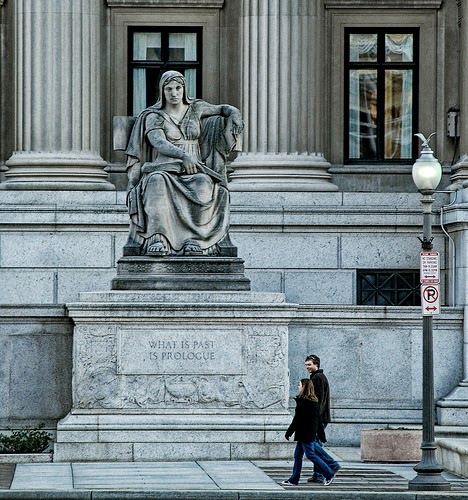An Open Letter to David Ferriero AOTUS
David Ferriero - Archivist of the United States - with historic records
Dear David Ferriero,
As the Archivist of the United States - "the Collector in Chief," you are responsible for the protection and maintenance of America's historic records, including the Declaration of Independence, the Constitution and the evidence and official records of the assassination of President Kennedy.
As a fellow blogger, Archives researcher and Walt Whitman fan I was struck by your blog post -"Calling all Whitman Fans," [http://blogs.archives.gov/aotus/?p=5342] as I found it hard to believe that over 3,000 previously unknown Whitman records could have secretly existed among the stacks at the Archives I also wrote about it.[ Whitman Treasure Trove Discovered at Archives | KellysCafe and JFKcountercoup: JFK Research At An Impass]
Their discovery gives me hope that more such historic records exist and await being found, especially among the many lost, missing and still with held records of the assassination of President Kennedy, the subject of much of my research.
As you are a former Navy corpsman - thank you for your service in Vietnam, you say you have an
interest in Navy records, so you should be interested to know of the sorry status of the ONI records of the assassination - many lost, missing and wrongfully withheld today.
The Archives II where the Whitman documents were found, is also where the JFK Records Collection is located, and the building was financed by the overwhelming Congressional support for the JFK Act. Yet Congress has not held an oversight hearing on the JFK Act in 17 years.
As the AOTUS you are responsible for the implementing of the law - 44 U. S. C. 2107 [FKCountercoup2: 44 U.S.C. 2107 - JFK Act] which states: "The remaining provisions of this Act shall continue in effect until such a time as the Archivist certifies to the President and the Congress that all assassination records have been made available to the public in accordance with this Act."
So the law remains in effect until such a time when you have determined all the records are released, an event that should have already happened.
Therefore I have started this petition to request that you fulfill your responsibility as Archivist and ensure that the law of the land - the JFK Act of 1992 and see that Congress does its duty and holds oversight hearings to determine what became of the missing evidence and records [JFKCountercoup2: The Last Congressional Hearing on the JFK Act - 17 Years Ago].
And that you, and not some unknown successor, will at such a time, and in our life time, inform the President, Congress and the American people that the last withheld JFK assassination record has been released.
William E. Kelly, Jr.
Petition | Please carry out your duty as AOTUS and ensure the JFK Act of 1992 is fully implemented. | Change.org
David Ferriero - Archivist of the United States - with historic records
Dear David Ferriero,
As the Archivist of the United States - "the Collector in Chief," you are responsible for the protection and maintenance of America's historic records, including the Declaration of Independence, the Constitution and the evidence and official records of the assassination of President Kennedy.
As a fellow blogger, Archives researcher and Walt Whitman fan I was struck by your blog post -"Calling all Whitman Fans," [http://blogs.archives.gov/aotus/?p=5342] as I found it hard to believe that over 3,000 previously unknown Whitman records could have secretly existed among the stacks at the Archives I also wrote about it.[ Whitman Treasure Trove Discovered at Archives | KellysCafe and JFKcountercoup: JFK Research At An Impass]
Their discovery gives me hope that more such historic records exist and await being found, especially among the many lost, missing and still with held records of the assassination of President Kennedy, the subject of much of my research.
As you are a former Navy corpsman - thank you for your service in Vietnam, you say you have an
interest in Navy records, so you should be interested to know of the sorry status of the ONI records of the assassination - many lost, missing and wrongfully withheld today.
The Archives II where the Whitman documents were found, is also where the JFK Records Collection is located, and the building was financed by the overwhelming Congressional support for the JFK Act. Yet Congress has not held an oversight hearing on the JFK Act in 17 years.
As the AOTUS you are responsible for the implementing of the law - 44 U. S. C. 2107 [FKCountercoup2: 44 U.S.C. 2107 - JFK Act] which states: "The remaining provisions of this Act shall continue in effect until such a time as the Archivist certifies to the President and the Congress that all assassination records have been made available to the public in accordance with this Act."
So the law remains in effect until such a time when you have determined all the records are released, an event that should have already happened.
Therefore I have started this petition to request that you fulfill your responsibility as Archivist and ensure that the law of the land - the JFK Act of 1992 and see that Congress does its duty and holds oversight hearings to determine what became of the missing evidence and records [JFKCountercoup2: The Last Congressional Hearing on the JFK Act - 17 Years Ago].
And that you, and not some unknown successor, will at such a time, and in our life time, inform the President, Congress and the American people that the last withheld JFK assassination record has been released.
William E. Kelly, Jr.
Petition | Please carry out your duty as AOTUS and ensure the JFK Act of 1992 is fully implemented. | Change.org



.JPG)
